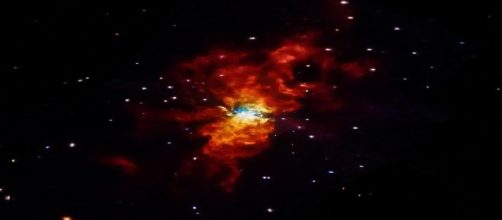Most luminous Supernova
On June 15, 2015 a group of scientists discovered a tremendous stellar explosion, which they named ASASSN-15th, utilizing the All Sky Automated Survey for Supernovae (ASASSN). This was the most luminous supernova ever detected, with an absolute magnitude of -23.5, which exceeds by 50 times the brightness of the whole Milkyway Galaxy and it´s twice as luminous as any other known supernova. It is estimated to be 3.8 light years from the earth in the direction of the southern Indus Constellation.
Supernova explosions
A supernova is a gigantic explosion of a star and it´s one of the most powerful explosions in the universe.
This kind of event occurs when the core of a star experiences a change. This change can originate in two different ways, each of them resulting in a supernova.
The first kind of supernova occurs in binary systems of stars, orbiting the same stellar point. Often binary stars can exchange mass. When a white dwarf accrues mass from a nearby star, it may reach the Chandrasekhar limit of 1.44 the mass of the sun, which causes it to explode as a supernova.
The other type of supernova happens at the end of a massive star lifespan, when the star has used all of its fuel to produce energy. When this happens, the star collapses under its own gravity. When the collapsation reaches the outer limits of the star’s core, it causes the violent expulsion of the outer layers of the star resulting in a Supernova explosion.
Super Luminous Supernovae (SLSNe)
Super Luminous Supernovae are the newly discovered cases of stellar explosions that are from 10 to several hundred times more powerful than any other known supernovae. It´s believed that these kind of supernovae could be powered by highly magnetized, and rapidly rotating neutron stars known as magnetars; however, the real source of their powerful luminosity is still a debate among scientists.
SN 2011kl and ASASSn-15th are the most recent cases of SLSNe. In a graphic analysis of their gamma ray spectrum, the first discovered SLSNe, SN 2011kl showed a super gamma ray burst that went on for several hours; while the normal gamma ray burst of previous known supernovas fade away in just minutes.
The most recently discovered SLSNe, ASASSn-15th´s luminosity lasted for over a month, exceeding in brightness that of any other supernova by several hundred times.
From Supernova to Magnetar
A little more than a decade ago, most astrophysicists would have assumed such large explosions only happened in the early universe, when very massive stars were more common; however, after the powerful Supernovae were discovered, they developed new ways to describe them.One assumption on how this type of Supernovae occur states that it could be powered by a highly magnetic rotating neutron star or magnetar, which is the remnant of a supernova after it has burned all of its fuel and has gone through collapsation and then explosion in the end of its life.
When a huge star explodes into a Supernova, it might produce a twirling body of neutrons the size of city creating highly magnetic field that heats up the expanding particles, thus brightening the explosion; however, scientists think that the newly luminous supernova is way too luminous for this hypothesis.
The magnetar would at least have to rotate one thousand times per second and produce a magnetic field 10-100 trillion times that of the earth to produce such huge luminosity. Other theories appoint that the Supernova could have encountered a layer of gas that generated a shockwave; however, the supernova does not show hydrogen or helium contents which makes up a gas cloud.
This particular luminous Supernova, which is thought to be visible for the next couple of years, should give scientists a clue to what the real source of its enormous brightness come from.

